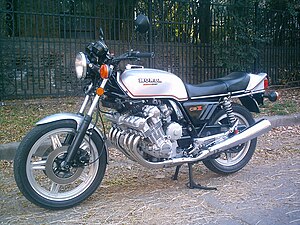Honda CBX1000
 |
|
| Manufacturer | Honda |
|---|---|
| Production | 1978–1982 |
| Class | Superbike |
| Engine | 1,047 cc (63.9 cu in) 24-valve, twin-cam air-cooled inline-6 6 carburetors |
| Bore / stroke | 64.5 mm × 53.4 mm (2.54 in × 2.10 in) |
| Compression ratio | 9.3:1 |
| Top speed | 134 mph (216 km/h) |
| Power | 100–105 hp (75–78 kW) |
| Transmission | 5-speed |
| Suspension | Front: 35 mm Telescopic fork Rear: Twin shock |
| Brakes | Front: Twin disc brakes 280 mm (11 in) Rear: Disc 305 mm (12.0 in) |
| Tires | Front 3.5 x 18" Rear 4.25 x 18" |
| Rake, trail | 27.5°, 4.7 in (120 mm) |
| Wheelbase | 1,495 mm (58.9 in) |
| Dimensions |
L: 2,220 mm (87 in) W: 780 mm (31 in) H: 1,145 mm (45.1 in) |
| Seat height | 810 mm (32 in) |
| Weight | 246.7 kg (544 lb) (dry) 272 kg (600 lb) (wet) |
| Fuel capacity | 20 l (4.4 imp gal; 5.3 US gal) |
| Fuel consumption | 6.00 L/100 km; 47.1 mpg‑imp (39.2 mpg‑US) |
The Honda CBX was a sports motorcycle manufactured by Honda from 1978 to 1982. With a 1047cc inline six-cylinder engine producing 105 bhp (78 kW), it was the flagship of the Honda range. The CBX was well received by the press, but was outsold by its sibling, the Honda CB900F.
As a promotional exercise, CBX bikes were ridden by travelling marshals at the 1979 & 1980 Isle of Man TT.
Honda had produced a Honda RC series six-cylinder race bike in the mid-1960s, but the CBX was Honda's first production 6 cylinder road bike. The CBX's advanced DOHC 24-valve inline six-cylinder engine was its outstanding feature; but in other respects the bike was conventional, having telescopic forks, a tubular frame, twin rear shocks and straight handlebars.
Although bulky, the engine was wide only at the top. The width across the crankshaft was relatively narrow as the CBX had a stacked engine ancillary arrangement, whereby the alternator and ignition items were sited behind the cylinder block. This arrangement produced an acceptable engine width low down and moved critical items out of harm's way in the event of grounding.
Journalist L. J. K. Setright wrote of the CBX's width: "Don't tell me that its engine is too wide: It is no wider than the legs of a rider, so it adds nothing to the frontal area, and personally I would rather have my legs shielded by a cylinder apiece than exposed to every blow ..."
In 1981, Honda repositioned the CBX into the sport touring category with the CBX-B, adding Pro-Link monoshock rear suspension, air-adjustable 39 mm front forks, a fairing and panniers. The CBX was given dual ventilated front brake discs to help retard the bike's 272 kg (600 lb) weight. The 1982 model CBX-C model differed little from the 1981 model, having only some changes to paint and trim.
...
Wikipedia
